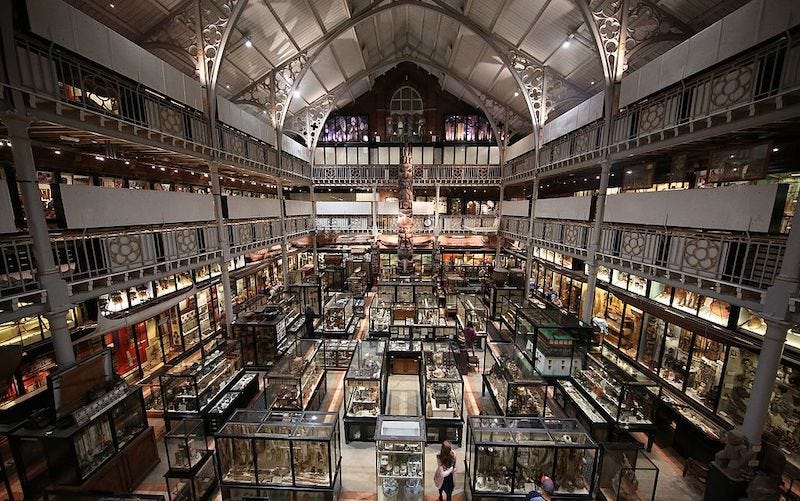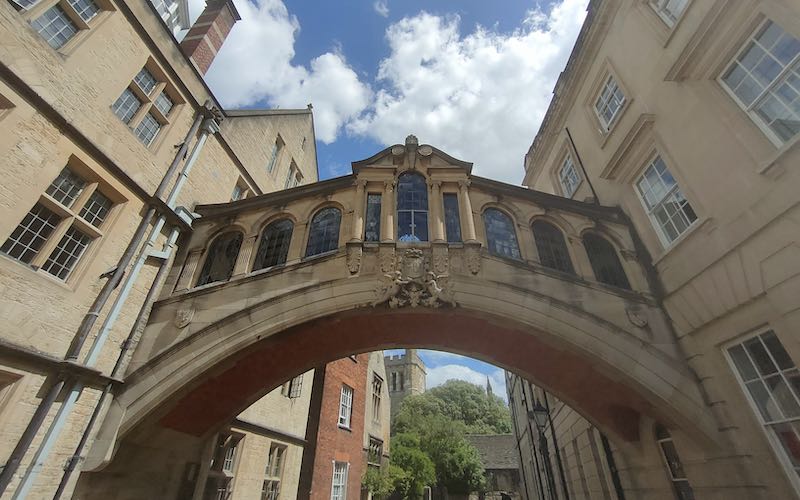The beautiful city of Oxford is home to the oldest University in Britain which was established in 1096. The city is full of green spaces, historical architecture and Church spires. Spend at least 2 days in the city if time allows. Many people see Oxford as a day trip, but I feel that it warrants much more than that, especially if you want to explore the free museums. In this travel blog, we will look at a range of the best free things to do in Oxford. It can be an expensive city, but it doesn’t have to be! If you’re searching for something to do while you’re in Oxford on a budget, these places are worth checking out.
How to get to Oxford
Oxford City Centre is walkable from Oxford train station and there are regular trains from London and Birmingham. If you are travelling to Oxford from the Northern Cities such as Liverpool or Manchester then you may have to change at Birmingham New Street. Remember that trains in the UK are cheaper if you book them in advance. You can book your ticket on www.thetrainline.com.
There are also coaches that go straight to Oxford from Heathrow airport. Book online with National Express.
The Best Free Things to do in Oxford
There are many fantastic museums in Oxford that are free to get into including the Pitt Rivers, the Museum of Natural History and the Ashmolean Museum. If it’s architecture that you are looking for then head to All Souls College or Oxford Town Hall. One things is for sure — you will never be short of free things to do in Oxford. If you are looking to save the pennies and stretch the budget even further then you will find Oxford to be a great city to sit and have a picnic — as long as you pick a good weather day!
Pitt Rivers Museum
The Pitt Rivers Museum displays one of the world’s most important anthropological and international archaeology collections. It’s my favourite out of all of the free things to do in Oxford. The collection includes tens of thousands of common things that highlight the diversity of cultural responses to the same basic difficulties that we all confront as human beings, and it comes from all corners of the globe and all times of human history. The museum’s unusual displays emphasise this point, grouping artefacts mostly by type or purpose rather than the culture or country from which they originate. A huge and valuable collection of fieldwork and other images, as well as audio recordings and manuscripts, complements the object collection. The Museum is free to enter, however all donations are appreciated and help to keep it that way.

Museum of Natural History
The Natural History Museum in London is a natural history museum that has a diverse collection of specimens from several fields of science. Botany, entomology, mineralogy, palaeontology, and zoology are among the museum’s five core collections, which house 80 million specimens of life and earth science. The museum is a research centre that focuses on taxonomy, identification, and conservation. The Natural History Museum, like other publicly supported national museums in the United Kingdom, does not charge an admission fee. Don’t miss the Natural History Museum’s newest exhibits, including the annual Wildlife Photographer of the Year exhibition, which features amazing natural-world photography.
Ashmolean Museum
The University of Oxford’s art and archaeology museum, the Ashmolean, was established in 1683. From Egyptian mummies and classical sculpture to the Pre-Raphaelites and modern art, the museum offers a vast and diverse collection from all over the world. Among its many treasures are the world’s greatest collection of Raphael drawings, the most important collection of Egyptian pre-Dynastic sculpture and ceramics outside Cairo, the only great Minoan collection in Britain, exceptional Anglo-Saxon treasures, the world’s most famous violin, Stradivari’s Messiah, and the Western world’s major collection of modern Chinese painting. Admission to the museum is free, and walk-up tickets are now available at the entrance. However, booking tickets in advance is suggested to ensure entrance during busy times and prevent lines. For exhibitions, reservations are still strongly advised. There is usually an additional paid exhibition on the top floor of the Museum and these exhibitions change regularly.
Bridge of Sighs
The Grade II listed Hertford Bridge, often known as the Bridge of Sighs because of its likeness to a similar bridge in Venice, spans New College Lane and connects Hertford College’s Old and New Quadrangles. The Bridge of Sighs, which is located directly across from the entrance to the Bodleian Library was never intended to be a reproduction of the Venetian bridge and instead resembles the Rialto Bridge in the same city. Regardless, the bridge is a favourite photo location for tourists and novices alike. Observe the bridge’s design, particularly the different shapes of its exquisite windows and the coat of arms in the centre. Whilst you are welcome to see the bridge from the street, you must be a Hertford College student to cross it.

Christ Church Meadow
Christ Church Meadow is a unique open space in the centre of Oxford that is accessible to the public all year. The meadow is highly unpredictable, with seasonal flooding and a variety of animals that comes and goes, despite its placid appearance. Christ Church Meadow is a unique open space in the centre of Oxford that is accessible to the public all year. The meadow is highly unpredictable, with seasonal flooding and a variety of animals that comes and goes, despite its placid appearance. It’s a popular place for sports, in fact it’s rumoured that you can see people playing ‘Quidditch’ on the Meadows! The Christ Church Meadow has a wonderful river with animals all around it. Near the visitor centre, there are also some wonderful tiny memorial gardens.
History of Science Museum
The History of Science Museum in Oxford, which is located on Broad Street, houses a significant collection of scientific instruments dating from the Middle Ages to the nineteenth century. The collection, as well as the building itself, today holds a unique place in the study of science history and the evolution of western culture and collecting. Einstein’s Blackboard, which Albert Einstein used in his lectures at the University of Oxford on May 16, 1931, is one of the most iconic pieces in the collection. They house an unrivalled collection of scientific inventions, technologies, and equipment from various cultures, countries, and periods throughout human history.
Port Meadow
Port Meadow is one of the city’s major open spaces. The river Thames, which runs through the heart of the meadow and are home to a variety of cattle, horses, and birds. Port Meadow is governed by the Countryside Act, and visitors must adhere to the Countryside Code when visiting. If you choose to swim in Oxford’s rivers, be aware that you do so at your own risk and that you are familiar with the wild water code. Barbeques are not allowed on the meadows and remember to take everything you bring onto the meadow home with you. It’s a lovely spot to walk, with outstanding scenery and different types of trees.
Cuttleslowe and Sunnymead Park
Cutteslowe and Sunnymead Park, in the north of Oxford, is the city’s biggest park. This huge, leafy park is a lovely spot to visit to get away from the hustle and bustle of the city, with great spreading woodland and nature areas, a safe place to bring children to play, and recreational facilities to keep everyone on their toes. At Cutteslowe and Sunnymead Park, you can participate in a range of sports. Choose from cricket, football, basketball, table tennis, beach volleyball, tennis, or geocaching to find treasures. San Remo, the Park’s freshly remodelled café, serves a variety of refreshments, including hot and cold beverages, as well as a great fresh selection of pastries and daily specials.
Oxford Town Hall
This magnificent Victorian structure not only serves as a management, social, and cultural hub for residents and visitors, but it also serves as a multipurpose venue and home to the Museum of Oxford. This Victorian listed building in the centre of Oxford can accommodate large, magnificent weddings as well as smaller, more intimate ceremonies and celebrations. The main entrance to the Town Hall is located halfway up the main building on St Aldate’s, up two short flights of stone steps. The Lord Mayor’s parlour, the Court Room, and the Council Chamber are all on display. All other rooms in the Town Hall are available on a first-come, first-served basis.
All Souls College
All Souls College college is available to the public on Sunday and weekday afternoons from 2 to 4 p.m., and admission is free. The College’s main entrance is on High Street, near Catte Street. The College Front, the Great Quadrangle, and the chapel are all open to visitors. Even though it is only a minor section of the campus, a stroll through the quadrangles is worthwhile. The gardens and quadrangle is magnificent with the huge, grassed square surrounded by the spectacular old college buildings. This is one of the most beautiful free things to do in Oxford, especially if you are into history of the colleges.
University Church Oxford
Last, but certainly not least on my list of free things to do in Oxford is the University Church of St Mary the Virgin – one of the most beautiful Churches in Oxford. It is a bright and inclusive Church of England Church that has served the student community over hundreds of years. The building itself is stunningly beautiful inside and out, with exquisite stained glass. The grounds include the Holywell cemetery. The Church itself is free to enter for visitors. You can visit the Church gift shop and also opt to pay to go up the Tower which gives fantastic views of the city. It’s £5 to climb the Tower and this is only for ages 8+.
Westgate Shopping Centre
If you want to explore the modern side of Oxford then head to Westgate Shopping centre. It was built in 1970 but extensively remodelled recently in 2016 and 2017. Check out the high fashion labels, eclectic restaurants and fancy bars that Westgate has on offer. You can spend money, but you don’t have to!
Further Places to Explore in Oxford
If you can spare an extra day and a bit of cash to visit Blenheim Palace, I would highly recommend it. The view across the pool was famously described as ‘the finest view in England. Blenheim Palace is in Woodstock and was the home of Winston Churchill. The cost to get in is £32.00 per adult and there are concessions for students and OAPs. To get to Blenheim Palace from Oxford take the S2 to Woodstock. I would recommend a full day to visit Blenheim.
If you have a bit of money to spend in Oxford I would highly recommend a visit to Oxford Castle and Prison. The castle is a great example of a 12th and 13th Century Motte and Bailey Castle. A Castle ticket is £15.25 and admission is by guided tour only. You can book your tickets online and in advance here. It’s one of my top 10 things to do in Oxford!
Enjoy this fabulous city! Got anything to add to this list? Feel free to comment on my blog — I’d love to hear from you.
